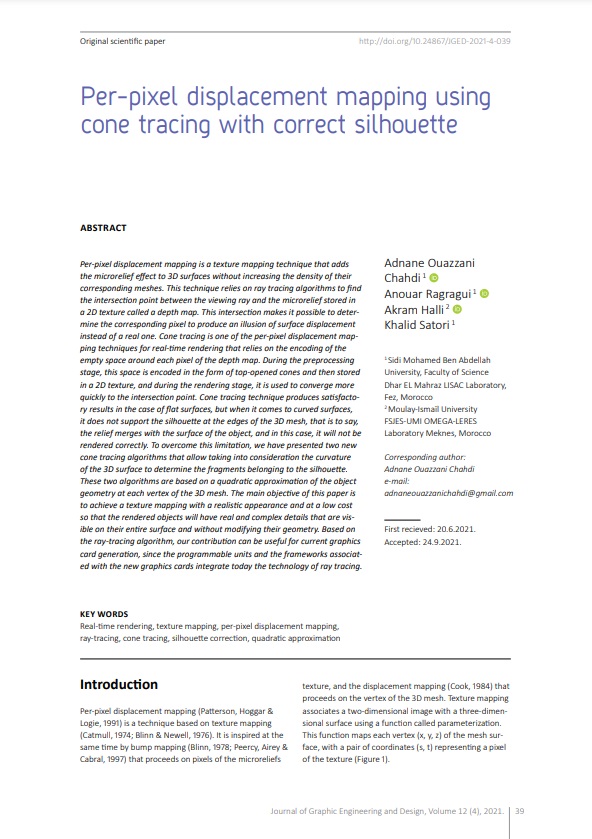
Published 2021-12-01
abstract views: 259 // Full text article (PDF): 171
Keywords
- Real-time rendering,
- texture mapping,
- per-pixel displacement mapping,
- ray-tracing,
- cone tracing
- silhouette correction,
- quadratic approximation ...More
How to Cite
Copyright (c) 2021 © 2021 Authors. Published by the University of Novi Sad, Faculty of Technical Sciences, Department of Graphic Engineering and Design. This article is an open access article distributed under the terms and conditions of the Creative Commons Attribution license 3.0 Serbia.

This work is licensed under a Creative Commons Attribution 3.0 Unported License.
Abstract
Per-pixel displacement mapping is a texture mapping technique that adds the microrelief effect to 3D surfaces without increasing the density of their corresponding meshes. This technique relies on ray tracing algorithms to find the intersection point between the viewing ray and the microrelief stored in a 2D texture called a depth map. This intersection makes it possible to determine the corresponding pixel to produce an illusion of surface displacement instead of a real one. Cone tracing is one of the per-pixel displacement mapping techniques for real-time rendering that relies on the encoding of the empty space around each pixel of the depth map. During the preprocessing stage, this space is encoded in the form of top-opened cones and then stored in a 2D texture, and during the rendering stage, it is used to converge more quickly to the intersection point. Cone tracing technique produces satisfactory results in the case of flat surfaces, but when it comes to curved surfaces, it does not support the silhouette at the edges of the 3D mesh, that is to say, the relief merges with the surface of the object, and in this case, it will not be rendered correctly. To overcome this limitation, we have presented two new cone tracing algorithms that allow taking into consideration the curvature of the 3D surface to determine the fragments belonging to the silhouette. These two algorithms are based on a quadratic approximation of the object geometry at each vertex of the 3D mesh. The main objective of this paper is to achieve a texture mapping with a realistic appearance and at a low cost so that the rendered objects will have real and complex details that are visible on their entire surface and without modifying their geometry. Based on the ray-tracing algorithm, our contribution can be useful for current graphics card generation, since the programmable units and the frameworks associated with the new graphics cards integrate today the technology of ray tracing.
Article history: Received (June 20, 2021); Revised (September 22, 2021); Accepted (September 24, 2021); Published online (December 1, 2021)

